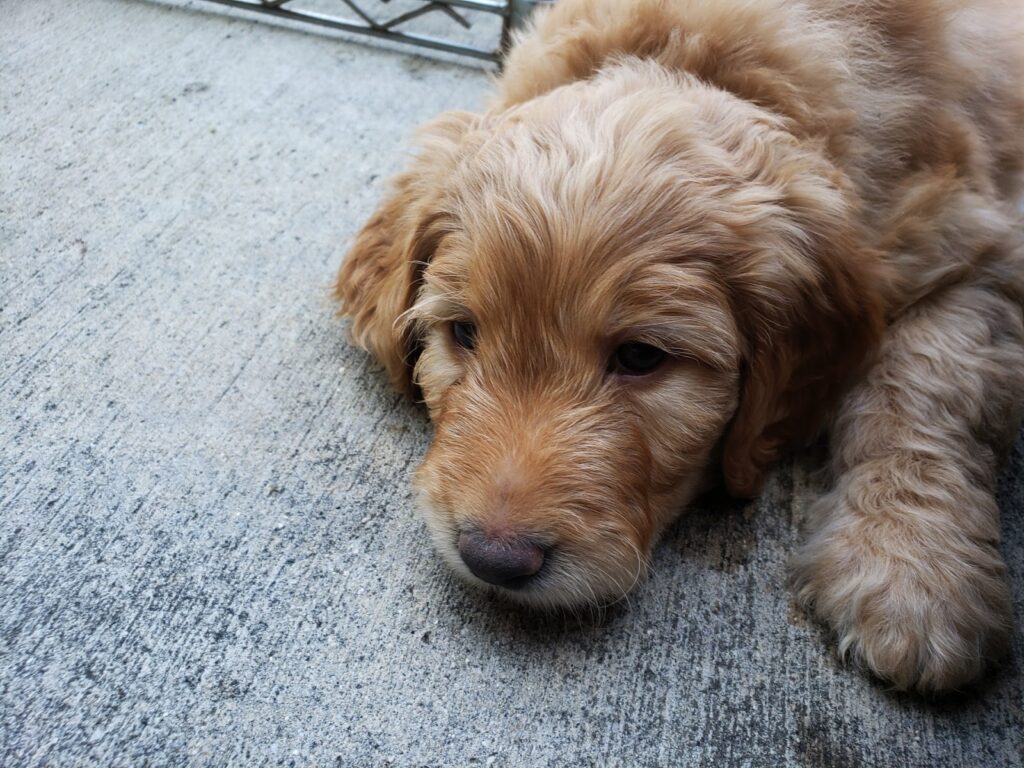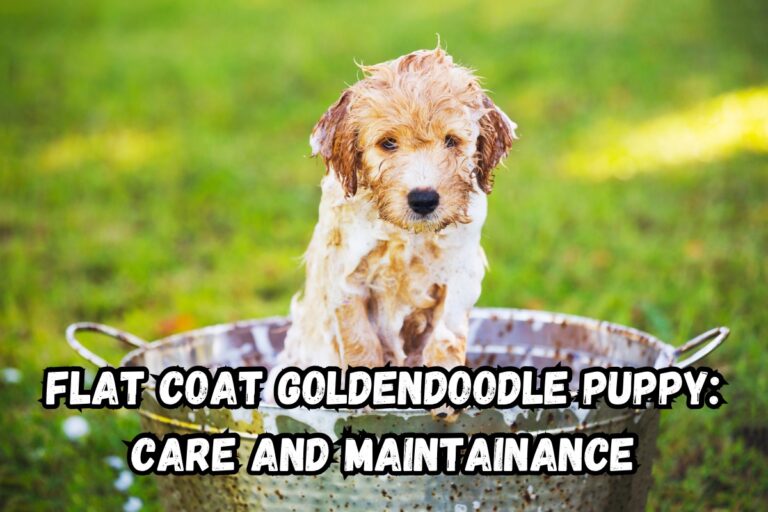
Welcome to the wonderful world of Flat-Coat Goldendoodles! If you’re reading this, you might be a new pet parent to one of these adorable furballs, or perhaps you’re just doodle-curious.
Either way, you’re in for a treat. These charming pups are known for their loving nature, intelligence, and, of course, their distinctive flat coats that make them stand out in the canine crowd.
But let’s paws for a moment. Owning a Goldendoodle isn’t just about enjoying their cuddles and playful antics; it comes with a ‘leash’ of responsibilities. From their unique nutritional needs to their fluffy coats that require regular grooming, there’s a lot to learn about keeping your doodly companion happy and healthy.
Fear not! This guide is your one-stop-shop for all things Flat-Coat Goldendoodle. We’ll dive into their diet, discuss the ins and outs of grooming, unravel the mysteries of training, and even take a stroll through their health and exercise needs.
Understanding Your Flat-Coat Goldendoodle

This section delves into their physical characteristics, temperament, and common health concerns, providing you with the essential knowledge to care for your pet effectively.
- Size: Flat-Coat Goldendoodles are a delightful blend of the stately Golden Retriever and the intelligent Poodle. Typically, they fall into the medium to large size category, with their weight ranging from 50 to 90 pounds. Their height can vary between 20 to 24 inches at the shoulder, depending on whether they lean more towards their Golden Retriever or Poodle ancestry.
- Coat Type and Appearance: One of the most distinctive features of the Flat-Coat Goldendoodle is their coat. As the name suggests, they possess a flatter coat compared to the often curly or wavy Goldendoodle.
This coat can range from straight to slightly wavy and is usually medium to long in length. Their fur is softer and denser, a characteristic inherited from the Golden Retriever, blended with the hypoallergenic qualities of the Poodle. Common coat colors include cream, gold, red, and sometimes black or multi-colored patterns.
Temperament and Behavior

Flat-Coat Goldendoodles are renowned for their friendly and affectionate nature. They are incredibly social, thriving in the company of their human families and other pets. This breed is known for its:
- Intelligence: They are highly intelligent and eager to please, making them relatively easy to train. This intelligence comes with a need for mental stimulation; puzzle toys and training games are great ways to keep their minds active.
- Playfulness: They have a playful and gentle disposition, making them excellent companions for children.
- Loyalty: They form strong bonds with their families and are known for being loyal and protective.
- Energy Level: These dogs are active and enjoy being engaged in activities. Regular exercise is crucial for their physical and mental well-being.
Health Overview
While Flat-Coat Goldendoodles are generally healthy, they are predisposed to certain health conditions, a mix of concerns from both Golden Retrievers and Poodles. Awareness of these conditions is vital for early detection and prevention.
- Hip Dysplasia: Like many larger breeds, they can be prone to hip dysplasia, a condition where the hip joint doesn’t fit snugly into the hip socket. Regular exercise and maintaining a healthy weight can help manage this risk.
- Ear Infections: Their floppy ears can trap moisture and lead to infections. Regular ear checks and cleaning are essential.
- Heart Conditions: They can inherit heart diseases like their Golden Retriever ancestors. Regular veterinary check-ups are crucial for early detection and management.
- Allergies and Skin Issues: They can sometimes inherit skin sensitivities and allergies from the Poodle side. Monitoring their diet and skin condition can help in managing these issues.
Nutrition and Diet for Your Flat-Coat Goldendoodle Puppy
Proper nutrition is paramount for the health and well-being of your Flat-Coat Goldendoodle puppy. Understanding their dietary needs will help you provide the best care for your growing companion.
This comprehensive guide covers everything from essential nutrients to feeding guidelines, selecting the right food, and addressing common dietary concerns.
Basic Nutritional Needs
- Protein: As the building block of a healthy body, protein is crucial for your Goldendoodle’s muscle growth and repair. Look for high-quality animal proteins like chicken, lamb, or fish as the primary ingredient in puppy food. A protein content of 22-32% is ideal for growing puppies.
- Fats: Essential fatty acids, particularly Omega-3 and Omega-6, support brain development, energy levels, and coat health. Sources like fish oil or flaxseed can be beneficial. The fat content should be around 8-12% for puppies.
- Carbohydrates: While dogs don’t necessarily need carbs, they are a good source of energy. Whole grains or carbohydrates from vegetables are preferable. Avoid foods with fillers like corn or wheat gluten.
- Vitamins and Minerals: These are vital for bone growth, metabolism, and overall health. Puppy food should be fortified with a balanced mix of essential vitamins and minerals, including calcium and phosphorus for bone development.
- Water: Fresh, clean water should always be available. Hydration is crucial, especially for puppies who are more prone to dehydration.
Feeding Guidelines
- How Much to Feed: The amount of food your Goldendoodle puppy needs depends on their age, size, and activity level. Generally, puppies require about twice as many calories per pound of body weight as adult dogs. Refer to the feeding guide on your puppy food’s packaging and adjust as necessary based on your vet’s advice and your puppy’s growth.
- How Often to Feed: Puppies should be fed three to four times a day. This helps with digestion and keeps energy levels consistent. As they grow, you can reduce feeding to twice daily.
Choosing the Right Food
- Puppy-Specific Formulas: Choose a formula specifically designed for puppies. These foods have the right balance of nutrients for growth and development.
- Breed Size Specificity: Consider a formula tailored for medium to large breeds. These formulas ensure that your Goldendoodle doesn’t grow too quickly, which can be detrimental to their joint health.
- Quality Ingredients: Look for foods that list real meat as the first ingredient. Avoid products with artificial colors, flavors, or preservatives.
- Consult Your Vet: Your veterinarian can recommend the best food based on your puppy’s specific health needs, weight, and growth pattern.
Common Dietary Concerns
- Food Allergies and Sensitivities: Some Goldendoodles may develop allergies or sensitivities to certain ingredients like grains, beef, chicken, or dairy. Symptoms include itchy skin, ear infections, or gastrointestinal upset.
- Managing Allergies: If you suspect an allergy, consult your vet. They may recommend an elimination diet to determine the allergen. Hypoallergenic or limited ingredient diets can be beneficial.
- Obesity Prevention: Overfeeding can lead to obesity, putting your puppy at risk for joint issues, diabetes, and other health problems. Monitor their weight and adjust food intake accordingly.
- Transitioning Foods: When changing your puppy’s diet, do it gradually over a week to avoid digestive upset. Start with 25% new food mixed with 75% old food and gradually increase the new food percentage.
Grooming and Coat Care

Grooming is a crucial aspect of caring for your Flat-Coat Goldendoodle, ensuring both their physical health and comfort. Their unique coat requires specific attention, and establishing a regular grooming routine is vital.
Brushing and Combing
- Techniques: Use a slicker brush and a wide-tooth comb. Start by gently brushing the coat to remove tangles and loose hair, working in sections and being careful not to pull on the skin.
- Frequency: Brush your Goldendoodle at least three times a week. During shedding seasons, daily brushing helps manage the increased hair loss.
Bathing and Cleaning
- Products: Use a mild, dog-specific shampoo. For sensitive skin, choose hypoallergenic or oatmeal-based shampoos.
- Methods: Bathe your Goldendoodle every 4-6 weeks. Before bathing, thoroughly brush the coat to remove tangles. During the bath, gently massage the shampoo into the coat and rinse thoroughly to prevent residue buildup.
Ear and Dental Care
- Ears: Check and clean your dog’s ears weekly. Use a vet-recommended ear cleaner and a soft cloth or cotton ball. Never insert anything into the ear canal.
- Teeth: Brush your Goldendoodle’s teeth several times a week using a dog-specific toothpaste and toothbrush. Regular dental check-ups are also important.
Nail Trimming
- Safe Practices: Trim your dog’s nails every 3-4 weeks. Use a sharp, dog-specific nail trimmer and avoid cutting into the quick, which can cause bleeding and discomfort. If unsure, seek guidance from a professional groomer or vet.
Exercise Needs
- Daily Requirements: Goldendoodles are active and require at least 30 to 60 minutes of exercise daily. This can be split into two or more sessions.
- Activities: Include a mix of activities such as walking, running, fetching, and swimming. These activities not only keep them physically fit but also provide mental stimulation.
Safe Play Practices
- Toys and Games: Choose toys that are appropriate for your Goldendoodle’s size and strength. Avoid small toys that can be swallowed or chewed apart. Interactive toys like puzzle feeders are great for mental stimulation.
- Supervised Play: Always supervise play sessions, especially when introducing new toys or playing with other dogs, to ensure safety.
- Ideas for Fun: Hiking, beach trips, and visiting dog parks are great ways to enjoy the outdoors with your Goldendoodle. These activities provide new sights, smells, and experiences.
- Socialization: Outdoor adventures are also an opportunity for socialization with other dogs and people.
Conclusion
Your journey with your Goldendoodle will be filled with learning and laughter.
Every brush stroke during grooming, every step taken during walks, and every check-up at the vet’s office is an opportunity to strengthen the love and understanding between you and your furry friend.
Remember, the time and effort you invest in their well-being not only ensures their health and happiness but also deepens the irreplaceable bond you share.

